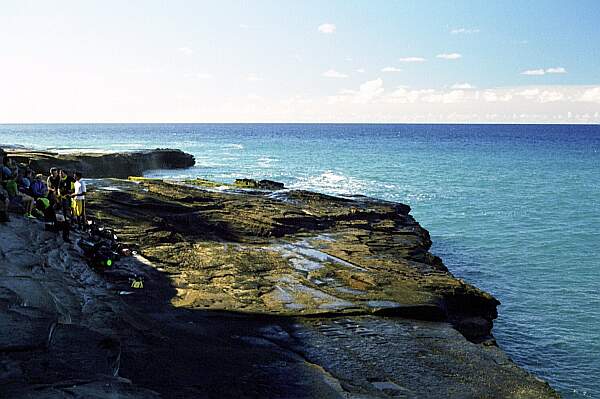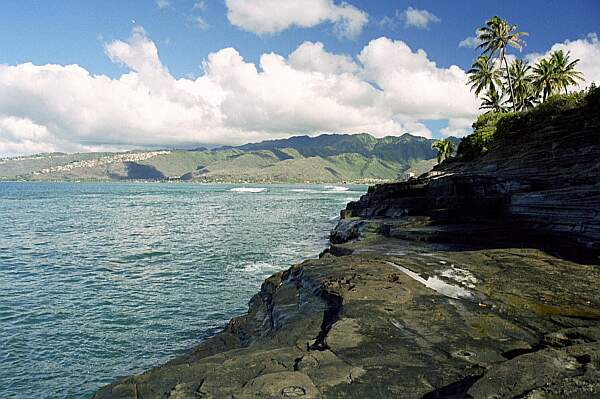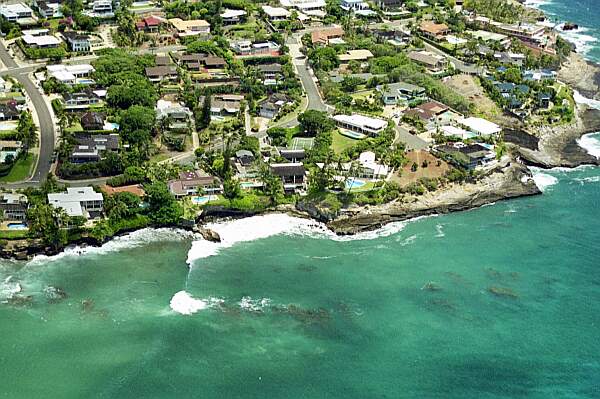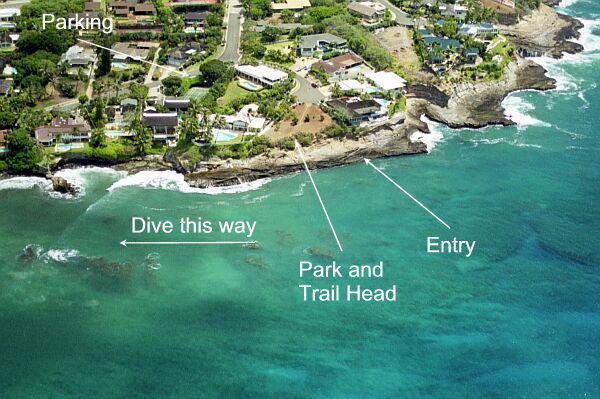Difficulty
intermediate
Viz (last reported 15029h ago)
Max Depth
Unknown
Snorkeling and Scuba Diving at Koko Kai Park
Koko Kai Park is mostly used as an entry for the previous site, Koke'e Park. It has a natural ledge that you may step on -- to do your giant stride on the next incoming swell. Exit is not easy at this site, which is why most will wait until the incoming tide, and then drift/swim to Koke'e Park beach. We recommend a guide to assist you with the first dive at this site.
Take Kalanianaole Highway (72) East toward Koko Head. Before heading up the side of Koko Head, turn right on Nawiliwili Street. After .3 miles turn left onto Poipu Drive. Bear right. After .6 miles turn right onto Hanapepe Loop. Bear Left. After .25 miles turn right into the park area.
Access
shore
View
Nearby Shops
Tide Report
Recommended dive shops
5
4
3
2
1
(15)
Zentacle
Sep 21, 2021, 1:05 AM
scuba
There are three entries to the lava shelf. Investigate which one will be easiest for you. Once on the shelf, head left and lava step will become apparent.
The entrance to the shelf is up above, and the girls have their feet on the natural step. Do not leave any gear close to the edge. A rogue wave could come along and gently sweep all your possessions out to sea!
Click the photo to see the parking and the entry.



3

David from Honolulu
Apr 2, 2012, 12:00 AM
scuba
Entry wasn't bad, but exiting is rough. We actually dove to the East/South to see some of the wall and reef. Not much coral or marine life was around and the current was pushing us around a good bit. Going away from the shoreline a good ways and the shelf drops to ~50ft, but there still isn't much out there. Bottom line - I DO NOT recommend this for anyone that isn't going with someone that knows exactly what they are doing and has experience with the area (that may, potentially, know better spots than what we saw). Currents are strong, exit is scary, and there isn't much to see. Go sit on the rocks some day just to hang out. That's what the spot is good for - not diving.
Originally posted on shorediving.com
John at Kaimuki
Sep 16, 2011, 12:00 AM
scuba
This is more commonly known as China Walls. The jump off China Walls is where we entered. The current brings you to the exit at Koke'e Beach Park as suggested. The surf was the calmest I have seen it with sets about 5 minutes apart. Within 5 mins of entry I was caught in fishing line. The surf pulling me back and forth created a nice saw action in my right calf. I had to cut my way free. It then became a fight against rock and surf to make it to the beach park. If you do as is suggested on this website the path back to Koke'e is very rough and only about 10 feet deep in the deepest spots. I will never dive here again.
Originally posted on shorediving.com
Barry W. Stieglitz
Sep 2, 2009, 12:00 AM
scuba
August 29, 2009. Whew! What a hairy dive exit! Rope must still be gone, as we couldn't find it. Definitely wear at least a rash guard, but a wet suit with gloves mo' betta, for the exit. I don't think most folks would want to do this on a flat sea, as one really needs a little swell (2-3') to get enough lift to flop back onto the ledge to exit like flotsam. :) On the negative side, the bottom was covered in lead sinkers and - yuck! - spark plugs?!?! We removed what we could.... On the positive side, the area resembled some areas of topography in the Mainland west: flat rock with the occasional 'butte' sticking up. The bottom itself was highly reticulated, like the pattern on the side of a scrawled filefish: beautiful. I think snorkelers (at least the hardy ones) would enjoy this site for the hardscape at least. We didn't see many big fish, but lots of people in the form of youngsters backflipping off the ledge and spearfishermen. At least one monk seal was filmed around the corner near Spitting Cave.
Originally posted on shorediving.com
ScubaFella43
Mar 17, 2007, 12:00 AM
scuba
Update!! I've been back twice, but conditions have been to cruddy to attempt entry both times. I did notice the rope is back so that will make the entry point easier to locate, just giant stride in to the right of the rope. Again, make sure you have a flag, as there's lots of boat traffic here.
Originally posted on shorediving.com
ScubaFella43
Oct 2, 2006, 12:00 AM
scuba
Ease of entry rates high because it's a giant stride in. We put our fins on in the water since the shelf is kind of narrow. The group I was with headed out the opposite direction shown on the picture; if you do this watch for current. We also exited where we entered, and that was pretty hard core, since THE ROPE IS GONE. I did not wear a full suit but wish I had since I scrapped up my shins and knees pretty good on exiting. If you want an easier exit swim on down to Koke'e Park. There were Octopi and some very nice areas to explore. Got down to about 50 feet, with great visibility. Rumor has it you can clearly hear whale song here at the right time of the year (December-April). I'll update this when I find out for sure.
Originally posted on shorediving.com
Allan Van Ness
Oct 17, 2004, 12:00 AM
scuba
I went here as part of a group of divers from a local dive shop. I probably wouldn't do it again since it was pretty difficult. Maybe the seas were rougher than normal, but I'd just say be careful. Once in the water, it was pretty cool. We saw a really big barracuda and a turtle.
Originally posted on shorediving.com
Seth Bareiss
Aug 8, 2004, 12:00 AM
scuba
Also known as Port Lock. This is basically the west outside wall of Hanauma Bay. The current photos of the entry point don't do it justice. There's a wiiiide rock shelf with a rope nailed to it: entry is by giant stride; exit is by holding onto the rope and Tarzan-swinging to exit as you ride a wave onto the shelf. Junk for snorkeling, but loads of fun for jumping into the water and Tarzan-swinging. The drift dive along the wall, starting further out (south), is a tricky entry... bring an experienced local, or you may break a leg or enter in the wrong place. Generally the place is very very divable, but on one occasion of the 150+ times I've dived there, a freak current dragged 5 of us out to sea so strongly that even tying off a rope on a coral head didn't save us, nor did lining up and kicking together. Quiz people exiting, about current, and watch the water carefully before entering. // People living around this area are tired of divers & surfers, so do not expect a welcome wagon if you need a phone, parking spot, or bathroom. There are no facilities here. Moderately popular as a SCUBA training site.
Originally posted on shorediving.com
Anonymous
Feb 4, 2004, 12:00 AM
scuba
If you look at the aerial picture we actually went in to the right almost to the end of the picture its the second to the last cove, we dove against the current for a while and then let the current bring us back to the entry point where we exited.
Originally posted on shorediving.com
Deven Phillips
Apr 15, 2002, 12:00 AM
scuba
The wall entry is actually a little intimidating, but not difficult. The exit is a little difficult and not recommended in higher surf (3-4 ft.). There are many different varieties of fish and eels. Many sea turtles can be spotted. Avoid entering the canyons too far, as they narrow and the surge could cause injury. If you swim far enough out toward Hanauma Bay, you will see several sea caves with a multitude of fish. I have been told that sometimes sharks can hang out in these caves, but I have not seen them.
Originally posted on shorediving.com
Robert Lower
Dec 31, 2001, 12:00 AM
scuba
Entrance it through a short path that leads down a small rocky cliff. Best is to jump off at a small cut in the wall slightly upwards from the main entry point. This is because strong diamond head bound currents are present year round making this dive good for an easy drift. Upon entering the water swim against the current (towards Molokai) along the wall to a small cave where white tipped reef sharks can usually be found sleeping. Then drift back down. Commonly seen here are manta rays, spotted eagle rays, green sea turtles, octopi, chevron and great barracuda, dragon morays, zebra morays, harlequin shrimp, tons of indigenous tropical marine life, and occasionally a whale shark (last reported spotted 12/19/01). The unique geography of this dive and dense marine population make this an enjoyable and easily navigated dive. At night turtles can be seen sleeping in the many caves along the wall, and spiny/slipper lobster are abundant. From January-May, large amounts of whales can be easily mistaken for speeding boats from shore.
Originally posted on shorediving.com